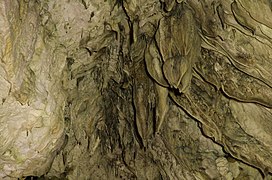Rosenmüller cave
| Rosenmüllerhöhle / Rosenmüllerhöhle
|
||
|---|---|---|
|
entrance |
||
| Location: | near Muggendorf ; Franconian Switzerland , Forchheim district , Bavaria ( Germany ) | |
| Height : | 430 m above sea level NHN | |
|
Geographic location: |
49 ° 48 '28.5 " N , 11 ° 15' 35" E | |
|
|
||
| Type: | Stalactite cave | |
| Discovery: | 1790 | |
| Show cave since: | 1836 to 1960 | |
| Lighting: | formerly with candles | |
| Overall length: | 112 m | |
The Rosenmüller cave , also known as the Rosenmüller cave , is a natural karst cave near Muggendorf, a district of the Upper Franconian community of Wiesenttal in the Forchheim district in Bavaria .
The cave was discovered in 1790 and is located in Franconian Switzerland , part of the Franconian Alb . The cave is registered as C 5 / 6133-1040 in the Franconian Alb cave cadastre (HFA).
Geographical location
The Rosenmüller Cave is located in the Franconian Switzerland-Veldenstein Forest Nature Park, about 600 m north of the center of Muggendorf, an east-south-east part of Wiesenttal . Its entrance is north above the Wiesent tals to approximately 430 m altitude on the southern slope of a wooded hill ( 494.1 m above sea level. NHN ).
History and description
The Rosenmüller cave was discovered in 1790 by Johann Ludwig Wunder, a son of the cave inspector Georg Wunder. The Leipzig doctor and professor of anatomy Johann Christian Rosenmüller was the first stranger to visit the cave in 1793. The cave was named after him in his honor.
The original entrance is about 13 meters high, so the cave could only be entered by arduous abseiling. The cave essentially consists of a 16 meter high main room and is 112 meters long after remeasurement. In order to operate the cave as a show cave , an 8 meter long artificial entrance was created in 1836, through which the cave can still be entered today. The cave was operated as a show cave from 1836 to 1960, making it one of the oldest show caves in Franconian Switzerland. The old guide path climbs over a sintered rubble dump (also known as " Parnassus "). At the upper end, individual corridors lead into further chambers, for example the wax chamber . The lighting with candles created a particularly romantic impression, the holders are still there today.
The Rosenmüller cave was one of the most beautiful stalactite caves in Franconian Switzerland. The cave has been freely accessible since the show cave was closed in 1960, and almost all of the stalactite jewelry was stolen as a result. There are still a few sintered structures on the ceiling . The original banister was replaced by a stainless steel banister (as of 2016).
The cave is designated as a natural monument.
Web links
- Rosenmüllerhöhle , on fhkf.de
- The Rosenmüller cave near Muggendorf in Our cave hiking tips on die-fraenkische-schweiz.com
- Rosenmüller Cave, on caveseekers.com
Individual evidence
- ↑ Map services of the Federal Agency for Nature Conservation ( information )
- ↑ Natural monuments in the Forchheim district , accessed on August 25, 2016, at lra-fo.de (PDF; 33.5 MB)







